Your surface is concave which means you can not use simple methods based on dot product between face normal and camera view direction.
You got 3 obvious options for this.
use ray tracing
as you got analytical equation of the surface this might be even better way
use depth buffering to mask out the invisible stuff
As you render wireframe then you need to do this in 2 passes:
- render invisible filled surface (fill just depth buffer not the screen)
- render wireframe
your depth buffer condition must contain also equal values so either z<=depth[y][x] or z>=depth[y][x]
However you need to use face rendering (triangles or quads ...) and I assume this is software rendering so if you not familiar on such stuff see:
use depth sorting by exploiting topology
If you do not have view transform so your x,y,z coordinates are directly corresponding to camera space coordinates then you can render the grid in back to front order simply by ordering the for loops and direction of iteration (its common in isometric views). This does not need depth buffering however you need to render filled QUADS in order to obtain correct output (border is set to the plot color and the inside is filled with background color).
I did go for the #2 approach. When I ported the last link into 3D I got this (C++ code):
//---------------------------------------------------------------------------
const int col_transparent=-1; // transparent color
class gfx_main
{
public:
Graphics::TBitmap *bmp; // VCL bitmap for win32 rendering
int **scr,**zed,xs,ys; // screen,depth buffers and resolution
struct pbuf // convex polygon rasterization line buffer
{
int x,z; // values to interpolate during rendering
pbuf() {}
pbuf(pbuf& a) { *this=a; }
~pbuf() {}
pbuf* operator = (const pbuf *a) { *this=*a; return this; }
//pbuf* operator = (const pbuf &a) { ...copy... return this; }
} *pl,*pr; // left,right buffers
gfx_main();
gfx_main(gfx_main& a) { *this=a; }
~gfx_main();
gfx_main* operator = (const gfx_main *a) { *this=*a; return this; }
//gfx_main* operator = (const gfx_main &a) { ...copy... return this; }
void resize(int _xs=-1,int _ys=-1);
void clear(int z,int col); // clear buffers
void pixel(int x,int y,int z,int col); // render 3D point
void line(int x0,int y0,int z0,int x1,int y1,int z1,int col); // render 3D line
void triangle(int x0,int y0,int z0,int x1,int y1,int z1,int x2,int y2,int z2,int col); // render 3D triangle
void _triangle_line(int x0,int y0,int z0,int x1,int y1,int z1); // this is just subroutine
};
//---------------------------------------------------------------------------
gfx_main::gfx_main()
{
bmp=new Graphics::TBitmap;
scr=NULL;
zed=NULL;
pl =NULL;
pr =NULL;
xs=0; ys=0;
resize(1,1);
}
//---------------------------------------------------------------------------
gfx_main::~gfx_main()
{
if (bmp) delete bmp;
if (scr) delete[] scr;
if (zed)
{
if (zed[0]) delete[] zed[0];
delete[] zed;
}
if (pl) delete[] pl;
if (pr) delete[] pr;
}
//---------------------------------------------------------------------------
void gfx_main::resize(int _xs,int _ys)
{
// release buffers
if (scr) delete[] scr;
if (zed)
{
if (zed[0]) delete[] zed[0];
delete[] zed;
}
if (pl) delete[] pl;
if (pr) delete[] pr;
// set new resolution and pixelformat
if ((_xs>0)&&(_ys>0)) bmp->SetSize(_xs,_ys);
xs=bmp->Width;
ys=bmp->Height;
bmp->HandleType=bmDIB;
bmp->PixelFormat=pf32bit;
// allocate buffers
scr=new int*[ys];
zed=new int*[ys];
zed[0]=new int[xs*ys]; // allocate depth buffer as single block
for (int y=0;y<ys;y++)
{
scr[y]=(int*)bmp->ScanLine[y]; // screen buffer point directly to VCL bitmap (back buffer)
zed[y]=zed[0]+(y*xs); // just set pointers for each depth line instead of allocating it
}
pl=new pbuf[ys];
pr=new pbuf[ys];
}
//---------------------------------------------------------------------------
int rgb2bgr(int col) // just support function reversing RGB order as VCL/GDI and its direct pixel access are not the same pixelformat
{
union
{
BYTE db[4];
int dd;
} c;
BYTE q;
c.dd=col;
q=c.db[0]; c.db[0]=c.db[2]; c.db[2]=q;
return c.dd;
}
//---------------------------------------------------------------------------
void gfx_main::clear(int z,int col)
{
// clear buffers
int x,y;
col=rgb2bgr(col);
for (y=0;y<ys;y++)
for (x=0;x<xs;x++)
{
scr[y][x]= 0x00000000; // black
zed[y][x]=-0x7FFFFFFF; // as far as posible
}
}
//---------------------------------------------------------------------------
void gfx_main::pixel(int x,int y,int z,int col)
{
col=rgb2bgr(col);
if ((x>=0)&&(x<xs)&&(y>=0)&&(y<ys)) // inside screen
if (zed[y][x]<=z) // not after something already rendered (GL_LEQUAL)
{
zed[y][x]=z; // update depth
if (col!=col_transparent) scr[y][x]=col;// update color
}
}
//---------------------------------------------------------------------------
void gfx_main::line(int x0,int y0,int z0,int x1,int y1,int z1,int col)
{
int i,n,x,y,z,kx,ky,kz,dx,dy,dz,cx,cy,cz;
// DDA variables (d)abs delta,(k)step direction
kx=0; dx=x1-x0; if (dx>0) kx=+1; if (dx<0) { kx=-1; dx=-dx; }
ky=0; dy=y1-y0; if (dy>0) ky=+1; if (dy<0) { ky=-1; dy=-dy; }
kz=0; dz=z1-z0; if (dz>0) kz=+1; if (dz<0) { kz=-1; dz=-dz; }
n=dx; if (n<dy) n=dy; if (n<dz) n=dz; if (!n) n=1;
// integer DDA
for (x=x0,y=y0,z=z0,cx=cy=cz=n,i=0;i<n;i++)
{
pixel(x,y,z,col);
cx-=dx; if (cx<=0){ cx+=n; x+=kx; }
cy-=dy; if (cy<=0){ cy+=n; y+=ky; }
cz-=dz; if (cz<=0){ cz+=n; z+=kz; }
}
}
//---------------------------------------------------------------------------
void gfx_main::triangle(int x0,int y0,int z0,int x1,int y1,int z1,int x2,int y2,int z2,int col)
{
int x,xx0,xx1,y,yy0,yy1,z,zz0,zz1,dz,dx,kz,cz;
// boundary line coordinates to buffers
_triangle_line(x0,y0,z0,x1,y1,z1);
_triangle_line(x1,y1,z1,x2,y2,z2);
_triangle_line(x2,y2,z2,x0,y0,z0);
// y range
yy0=y0; if (yy0>y1) yy0=y1; if (yy0>y2) yy0=y2;
yy1=y0; if (yy1<y1) yy1=y1; if (yy1<y2) yy1=y2;
// fill with horizontal lines
for (y=yy0;y<=yy1;y++)
if ((y>=0)&&(y<ys))
{
if (pl[y].x<pr[y].x){ xx0=pl[y].x; zz0=pl[y].z; xx1=pr[y].x; zz1=pr[y].z; }
else { xx1=pl[y].x; zz1=pl[y].z; xx0=pr[y].x; zz0=pr[y].z; }
dx=xx1-xx0;
kz=0; dz=zz1-zz0; if (dz>0) kz=+1; if (dz<0) { kz=-1; dz=-dz; }
for (cz=dx,x=xx0,z=zz0;x<=xx1;x++)
{
pixel(x,y,z,col);
cz-=dz; if (cz<=0){ cz+=dx; z+=kz; }
}
}
}
//---------------------------------------------------------------------------
void gfx_main::_triangle_line(int x0,int y0,int z0,int x1,int y1,int z1)
{
pbuf *pp;
int i,n,x,y,z,kx,ky,kz,dx,dy,dz,cx,cy,cz;
// DDA variables (d)abs delta,(k)step direction
kx=0; dx=x1-x0; if (dx>0) kx=+1; if (dx<0) { kx=-1; dx=-dx; }
ky=0; dy=y1-y0; if (dy>0) ky=+1; if (dy<0) { ky=-1; dy=-dy; }
kz=0; dz=z1-z0; if (dz>0) kz=+1; if (dz<0) { kz=-1; dz=-dz; }
n=dx; if (n<dy) n=dy; if (n<dz) n=dz; if (!n) n=1;
// target buffer according to ky direction
if (ky>0) pp=pl; else pp=pr;
// integer DDA line start point
x=x0; y=y0;
// fix endpoints just to be sure (wrong division constants by +/-1 can cause that last point is missing)
if ((y0>=0)&&(y0<ys)){ pp[y0].x=x0; pp[y0].z=z0; }
if ((y1>=0)&&(y1<ys)){ pp[y1].x=x1; pp[y1].z=z1; }
// integer DDA (into pbuf)
for (x=x0,y=y0,z=z0,cx=cy=cz=n,i=0;i<n;i++)
{
if ((y>=0)&&(y<ys))
{
pp[y].x=x;
pp[y].z=z;
}
cx-=dx; if (cx<=0){ cx+=n; x+=kx; }
cy-=dy; if (cy<=0){ cy+=n; y+=ky; }
cz-=dz; if (cz<=0){ cz+=n; z+=kz; }
}
}
//---------------------------------------------------------------------------
Just ignore/port the VCL stuff. I just added z coordinate to interpolation and rendering and also depth buffer. The rendering code looks like this:
//---------------------------------------------------------------------------
gfx_main gfx;
//---------------------------------------------------------------------------
float myFunc(float x,float y)
{
float z;
x-=gfx.xs/2;
y-=gfx.ys/2;
z=sqrt(((x*x)+(y*y))/((gfx.xs*gfx.xs)+(gfx.ys*gfx.ys))); // normalized distance from center
z=((0.25*cos(z*8.0*M_PI)*(1.0-z))+0.5)*gfx.ys;
return z;
}
//---------------------------------------------------------------------------
void view3d(int &x,int &y,int &z) // 3D -> 2D view (projection)
{
int zz=z;
z=y;
x=x +(y/2)-(gfx.xs>>2);
y=zz+(y/2)-(gfx.ys>>2);
}
//---------------------------------------------------------------------------
void draw()
{
int i,x,y,z,ds,x0,y0,z0,x1,y1,z1,x2,y2,z2,x3,y3,z3,col;
gfx.clear(-0x7FFFFFFF,0x00000000);
// render
ds=gfx.xs/50;
for (i=0;i<2;i++) // 2 passes
for (y=ds;y<gfx.ys;y+=ds)
for (x=ds;x<gfx.xs;x+=ds)
{
// 4 vertexes of a quad face
x0=x-ds; y0=y-ds; z0=myFunc(x0,y0);
x1=x; y1=y0; z1=myFunc(x1,y1);
x2=x; y2=y; z2=myFunc(x2,y2);
x3=x0; y3=y; z3=myFunc(x3,y3);
// camera transform
view3d(x0,y0,z0);
view3d(x1,y1,z1);
view3d(x2,y2,z2);
view3d(x3,y3,z3);
if (i==0) // first pass
{
// render (just to depth)
col=col_transparent;
gfx.triangle(x0,y0,z0,x1,y1,z1,x2,y2,z2,col);
gfx.triangle(x0,y0,z0,x2,y2,z2,x3,y3,z3,col);
}
if (i==1) // second pass
{
// render wireframe
col=0x00FF0000;
gfx.line(x0,y0,z0,x1,y1,z1,col);
gfx.line(x1,y1,z1,x2,y2,z2,col);
gfx.line(x2,y2,z2,x3,y3,z3,col);
gfx.line(x3,y3,z3,x0,y0,z0,col);
}
}
// here gfx.scr holds your rendered image
//---------------------------------------------------------------------------
Do not forget to call gfx.resize(xs,ys) with resolution of your view before rendering. As you can see I used different function (does not matter) here the output:

And here the same without depth condition in pixel(x,y,z,col)

The pbuf structure holds all the stuff that will be interpolated in the last rendering interpolation of the horizontal lines. So if you want gourard, textures or whatever you just add the variable to this structure and add the interpolation to the code (mimic the pbuf[].z interpolation code)
However this approach has one drawback. Your current approach interpolates one axis pixel by pixel and the other is stepping by grid size. This one is stepping both axises by grid size. So if you want to have the same behavior you might to do the first pass with 1 x 1 quads instead of ds x ds and then do the lines as you do now. In case 1 in your view is corresponding to pixel then you can do this on pixels alone without the face rendering however you risk holes in the output.



